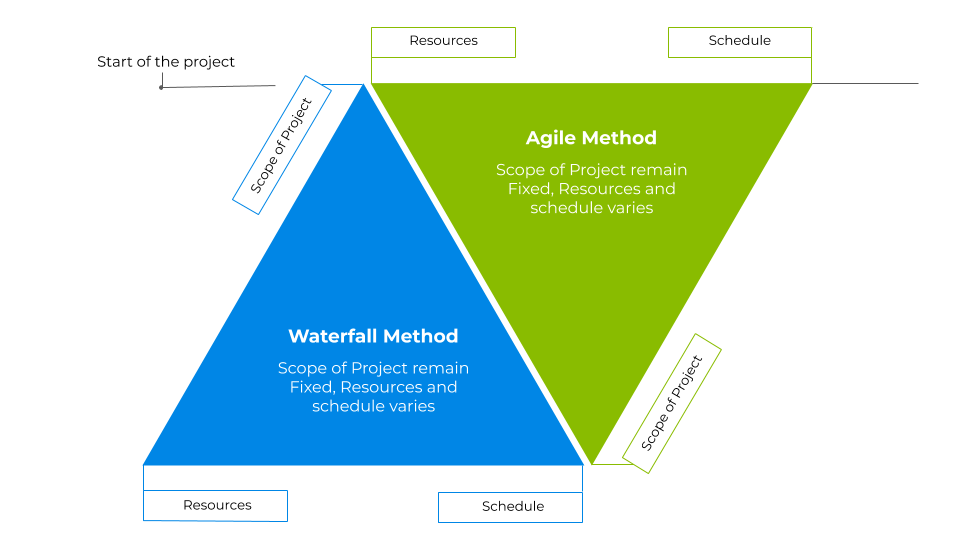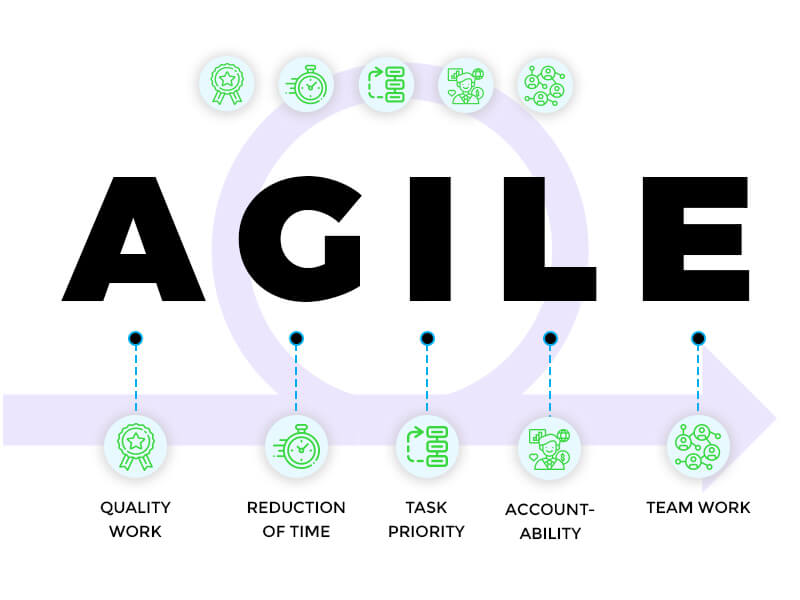
The world is getting smarter, right?
All in business today is about….?
Yes, you guessed it right! CUSTOMER SATISFACTION!
But it seems like a tough task to achieve every single time! That’s why we got, Management! with all its techniques, strategies, processes, etc.
Management style has evolved every now and then, finding better solutions. But today, working in the best possible way is important!
And for the same cause, Agile Project Management was designed for Software Development by some expert developers while trying to find their way out of heavyweight processes that consumed a lot of time, making results slow.
There have been many traditional processes included in management and software development, the most famous being Waterfall until Agile was introduced.
It has become the booming method in the IT sector to deliver rich projects at the right time. But eventually, Agile has been adopted by non-IT sectors too.
In this blog, you will clearly understand all the concepts related to Agile Project Management Methodology, what it is in present and what future holds for it.
Enjoy the Read!
- What is Agile Project Management?
- Agile Manifesto
- Phases of Agile Project Management(APM)
- Why use Agile?
- Challenges While Adopting Agile
- Misconceptions about agile
- How do you use agile effectively?
- Roles of Stakeholder in Agile Process
- Agile Methadologies
- Agile Is Not For You if……
- Advantages of Agile Project Management
- Disadvantages of Agile Project Management
- When can you use agile?
- Future of Agile Development Process
- Conclusion
What is Agile Project Management?
Let’s break the definition of APM for you to understand it better
APM is a process that
- Breaks down the project into small tasks called “sprints” or “iterations”
- Focuses on continuous work improvements
- Through regular meetings, discussions, customer feedback, etc.
These iterations of sprints can be of a few days or 1-3 weeks. Dividing tasks into smaller tasks helps to complete the task accurately.
Thus, you can divide Agile Project Management into three aspects:
- Iterative and incremental development
- Establishment of an effective team
- Effective Communication
Unlike traditional methods, APM is flexible and emphasizes continuous changes to improve and deliver expected outcomes.
Agile Manifesto
Agile project management manifesto framed by the 17 signatories consisted of 4 core values and 12 principles for Agile Methodology.
Have a look at what were these values and principles.
4 Core Values
1. Individuals and interactions over processes and tools
Depending on humans and their intellectual proves to be a better option than relying on rigid processes and also helps to implement changes conveniently
2. Working software over comprehensive documentation
Practice is more effective than theory. The same goes for any project.
Instead of spending unnecessary time on comprehensive documentation, your developers should invest time in working software.
However, documents that provide value in the given time can be created to help in the tasks.
3. Customer collaboration over contract negotiation
Customer Satisfaction is key for businesses in the 21st Century.
Keeping customers’ expectations and requirements on the top rather than negotiating contracts yield fruitful customer and end-user experience.
4. Responding to change over following a plan
Review and Correction are constantly done in agile.
With each sprint, there are regular and retrospective meetings included that report for the changes needed to be done.
Following a rigid may hinder the developmental changes that your project may require.
12 Principles
- Our highest priority is to satisfy the customer through early and continuous delivery of valuable software (or anything else you deliver).
- Welcome changing requirements, even late in development. Agile processes harness change for the customer’s competitive advantage.
- Deliver projects frequently, from a couple of weeks to a couple of months, with a preference for the shorter timescale.
- Coordinating team members must work together daily throughout the project.
You all are working on the same goal, after all. - Build projects around motivated individuals. Give them the environment and support they need and trust them to get the job done.
- A face-to-face conversation is the most efficient and effective method of conveying information to and within different teams.
- Working Software is the Primary Measure of Progress. Customers want what they want!
If the final product is not up to their expectations, it might be a problem. - Agile processes promote sustainable development. All stakeholders should be able to maintain a constant pace indefinitely.
- Continuous attention to technical excellence and good design enhances agility
- Simplicity—the art of maximizing the amount of work not done—is essential.
There is no use of making unwanted efforts when a task can be done simply. - The best architectures, requirements, and designs emerge from self-organizing teams
- Regular intervals are used by teams to improve efficiency through fine-tuning behaviors.
Keeping tabs on improvements required by experimenting is essential to achieve the best.
Phases of Agile Project Management(APM)
Agile has a specific way to get the work done while being flexible. The agile project management process is opposite to that of the traditional project management such as Waterfall.
This is explained by the Scope, Time and Cost Triangle, where Scope is fixed in Waterfall while agile has fixed iterations (time) and Cost fixed and scope is adjusted accordingly.

This whole working system of APM wraps up in these 6 phases. Here they are!
1. Project Planning
Before starting, you need to understand the project goal and objectives i.e. the scope of the project
Thus, in this initial phase, know everything you need to about the project you are going to work on.
2. Roadmap Creation
A roadmap includes all the features you need in a product and smaller tasks that you will need to accomplish in order to achieve the final product/goal.
Create a product backlog by listing out all the features needed and get all the members needed in your agile team.
3. Release Planning
Here, you need to do smaller tasks in a short span called ‘iterations’ or ‘sprints’.
Each of these sprints will release a single feature of the project. The completion of each sprint is a step towards finishing the final release.
4. Sprint Planning
Sprint planning includes:
- Delegating tasks included in a sprint to the team members evenly
- Targets to be accomplished in a sprint
All the tasks of a sprint will be assessed regularly.
Also while all the planning, it should be kept in mind that the tasks are to be kept open to any changes needed in future or further sprints.
5. Daily Meetings
All the team members meet daily and discuss what is done and what is needed to be done.
These are short meetings, ideally of 15 minutes or less. New aspects can be discussed and planned to be implemented and existing problems can be solved during these meetings.
6. Sprint Review and Retrospective
The first principle of APM concentrates on Customer Satisfaction and so after completion every sprint, you will hold a sprint review meeting to get the customer feedback, any new requirements, or any changes that need to be done.
Aside from customer review, you will hold a retrospective meeting with your team to discuss the sprint completed and about the next sprint on the way.
All in all, constant assessment keeps the objectives and requirements in-check.
Why use Agile?
Agile is the method of the modern age. Earlier, because of using traditional methods, companies were not able to deliver projects in time and with client’s expectations.

Agile serves to this by:
1. Giving the flexibility to make corrections
Did something go wrong? Or “This can be better” are always welcomed in Agile PM.
You don’t have to stick to a rigid plan that doesn’t cater to changes required by the time.
Deliver the best with Agile PM by making corrections and improving.
2. Quality work
Agile ensures the quality of each step before moving on to the next step by regular reviews and testing.
Whereas in traditional methods, the tasks were done according to the core plan, without looking back to the work done.
3. Reduction in release time
When you use agile project management, you assess, review, improve at every step with daily meetings, sprint review, retrospective meetings and thus every task is closed with extreme clarity.
Because of this, there is no need to look back and you can release your product in time less than that in traditional methods.
4. Tasks can be prioritized
With traditional methods, every step was taken according to the plan and with that, the urgency of any other task was ignored.
While in Agile, you can prioritize tasks as per the ongoing needs with the help of agile tools like Gantt Chart and tools using Kanban board.
5. Greater Accountability
A member is responsible for their task and has to take decisions by themselves, brainstorm the ideas, and review the tasks.
This strengthens your team’s skills and accountability and you can rely on them to complete the project without pressuring them.
6. Enhanced Teamwork
When you use an agile PM, working with the team becomes inevitable.
So, with or without a will, your team has to communicate constantly to complete sprints.
Even if anyone is new to agile, they eventually develop better communication and collaboration skills which enhance teamwork delivering enhanced results.
It seems pretty clear now that Agile PM not only takes care of customer satisfaction and projects better than traditional methods but also cultivates skills in your employees strengthening their productivity.
Challenges While Adopting Agile
As said by Philip Crosby “Slowness to change usually means fear of the new” and this fear can be a cause that may prove challenging while adopting agile.
Adopting agile doesn’t only concern you but to the whole organization, changing everything from HR policies to communication.
The common challenges that your organization may face at different levels while adopting agile methodologies can be :
For Management:

1. Resources Management
With agile, managers have to let go of the traditional method to be task managers.
In such a situation, the reign goes into the hands of the team and managers sometimes may fail to decide if their team is prepared to use agile.
Thus, risk awaits for availing proper resources.
2. Metrics and Measurement
Managers get used to traditional methods of measuring success.
This becomes tough when you use agile as it values the final outcome instead of metrics related to a number of tasks.
3. Risk Management
Though agile gives the best results because of its flexible nature, it involves the risk of uncertainty in terms of budget and time.
Until you are experienced to use agile, you can be vulnerable to these risks. This can be a stress giver point for the manager.
For Team

1. Reluctance to Change
Working long with old ways, teams get a misconception that agile teams don’t plan and work without any roadmaps.
Such thoughts may stop them from accepting agile with commitment.
2. Hesitant to Challenges
While employees may be skilled, some are not open to challenges.
And that could be a problem when you use agile.
Self-direction by team members is what drives projects using an agile methodology.
When employees are used to working according to the direction given, their productivity can decrease when they will have to self-govern their tasks.
3. Communication Barriers
Communication is comparatively minimal when you use traditional methods as compared to agile methods.
Agile needs constant and intrusive communication between all levels, especially at the team level, where they need to communicate with the management, customers and also internally.
For Customer/Stakeholder

1. Lack of Estimates
Customers always want to know the results beforehand.
While that was a characteristic of traditional methods, it is a little weak in agile.
Tasks are evaluated on a daily basis that may lead to changes in planning due to which any perfect estimates are hard to make.
2. Intense collaboration
There are highly negative chances of constant availability of customers for feedback and project discussions.
As agile principles focus on customer collaboration and customer satisfaction by being in constant touch with the customer, it needs heavy communication.
Your customer may have their own workload to be available for such communication.
3. Lack of Understanding
Employees are trained and fully guided to use agile methods while it can be tricky sometimes to make the clients understand the same.
This may develop a concern in their mind towards the success of the project.
Any change comes with challenges, and there is always a way to pass them. Passing through these challenges presents you with new skills and a better way to work.
Misconceptions about agile
1. Agile is only for small projects
Well yes, using agile can be tough for large and complex projects.
With little more effort by using multiple teams, timely co-ordinations, large and complex projects can be carried out successfully.
2. It works without planning
How can a project be managed without planning?
Planning is an integral part of any management activity.
Though agile does not work on the basis of intense planning. Sprint planning and release planning are done before initiating the project.
This planning can be prioritized and elaborate according to the demand in further times. Thus, agile does planning, which is flexible to be altered whenever needed.
3. Agile is only for tech people
This myth is one of the reasons this blog is titled “Agile Project Management” and not “Agile Software Development”.
It may be true that agile is majorly used in the IT industry, but it has been adopted in non-IT industries like manufacturing, education, etc.
Some non-IT businesses using agile are Lonely Planet, National Art Museum, NPR(National Public Radio), and Mission Bell Winery.
4. Governance is not a part of agile
Team members self-direct their tasks while working with agile methods. This does not imply that it does not have any governance.
Agile is equipped with daily meetings and regular task reviews. Setting a proper schedule for these meetings can prove to be good governance in agile PM.
5. Documentation is absent in agile
Unlike Waterfall, Agile methods need less documentation. The detailed planning is not done at the very beginning as in Waterfall.
Agile focuses on iterations and is adaptive to add to the plans according to the need of the moment. The documentation in agile is done for:
- Client needs
- Decisions made
- Reports for project status and performance metrics, and more
How do you use agile effectively?
Cracked! There are some core components of Agile PM that are to be taken care of crucially to make sure agile works effectively. Now, what are they? Let’s have a look at them to know:
1. Efficient Team
Select a team where team members are efficient in their work, adaptable to change and ready to deal with challenges.
2. Requirement Decisions
Decide the most-needed requirements of the project and finish them first. You can add any important requirements that come along the way.
Perks of flexibility!
3. Active Communication
Poor communication can make everything go wrong in agile. Therefore, make sure everyone in the team is actively communicating throughout the project. Poor communication can make everything go wrong in agile. Therefore, make sure everyone in the team is actively communicating throughout the project.
4. Encourage your team
Boost your team’s productivity by encouraging them to take decisions and evaluate their work on their own.
Make them realize the importance of their responsibility and authority.
5. Agile PMO(Project Management Office)
An Agile PMO becomes inevitable when you are working with agile methodologies as it needs special attention.
Traditional practices and agile practices are two very different implementations and thus an Agile PMO becomes necessary.
6. Small Tasks
Tasks should be as small as they can be completed in sprints i.e. in some weeks
7. Prototype
When you are developing a product and need reviews of your customer on it, you develop its prototype.
And with agile where customer satisfaction is of utmost importance, prototyping in time needs to be done to iterate and make small releases.
8. One Feature at a Time
Breathe and develop one feature at a time. Rush can mess up the tasks.
Focus on completing the task without any error.
9. Testing
Testing at every step in the project life cycle will let you move to the next task with clarity that will save you time and effort.
10. Customer Feedback
To deliver your customers what they want, you will need to clearly understand their needs.
Customer feedback is key to that. Keep taking reviews and get the right results with them by iterating and improving.
11. Embrace Change
Agile is based on iterations and you may feel frustrated when the number of iterations.
In order to make agile success, embrace the changes and learn from them.
Roles of Stakeholder in Agile Process
Unlike traditional practices, agile does not hold the authority to a single person. Here the Project Manager’s responsibility becomes a little different.
1. Product Manager/Owner
Determines the features, prioritizes them and provides User Stories(describes what features are needed, why and who needs them)
2. Customers
The role of customers in agile is to:
- Monitor progress
- Provide feedbacks
3. Project Manager
A project manager delegates tasks to team members runs daily meetings and sprint demos.
4. Developers
These are the team members who develop features and complete sprints. .
5. Resource Managers
As the title depicts, they are responsible to make sure the resources needed in the project are duly available are used in an optimized way.
6. QA/QE Manager/Testers
They test the product at each step to ensure quality by testing and making improvements
Agile Methadologies

Scrum
Sprints are a focal point in Scrum.
To elaborate, the Scrum methodology aims to complete a project by defining small tasks (sprints) which are to be finished in normally 2-3 weeks.
It doesn’t follow a particular organizational structure and hierarchy-based models.
Scrum Master and Product Owner are the two main roles in this method. The role of Scrum Master is the same as Project Manager in Agile.
Is Scrum for you?
Scrum is for you if your organization is a believer in the team-based approach and can authorize the team members for their tasks where they have to make decisions on their own.
However, if you follow a top-down approach, then it would be better to avoid using Scrum.
Lean
Lean methodology leans i.e. optimizes the time and resources for developing a product by eliminating waste thus delivering the value.
This is achieved through rapid and reliable communication between customers and developers, and iterations wherever required.
Is Lean for you?
Lean is for any organization as it simplifies the development process. Also, it requires development with a deep understanding of their work to apply Lean effectively.
Kanban
In Kanban, you focus on smoothening the workflow by visualizing it, reducing the pending work and prioritizing tasks.
This helps to create a proper workflow due to which teams can collaborate without fuss.
Is Kanban for you?
Kanban can prove to be highly effective for any organization using agile though it is preferable for small and midsized companies.
Extreme Programming (XP)
This methodology is concerned with providing high-quality software development through disciplined practices such as pair programming, rapid feedback, continuous testing, close teamwork.
With XP, it is intended to deliver the systems as early as possible and implement changes as demanded by the customers.
Is XP for you?
Extreme Programming is best for the companies with dynamic requirements, where customers’ needs change frequently and it’s difficult to formulate these needs.
Crystal
Crystal emphasizes on people and their interactions to tackle a project. It believes that the teams can best handle the projects among them.
Teamwork, communication, and simplicity are the core characteristics of Crystal. It aims to frequent delivery of working software, high user involvement, and adaptability.
Is Crystal for you?
It insists upon the importance of people working in the organization and if your organization wants the same as to empower your team and strengthen their skills, this method will suit you the best.
DSDM
Rapid delivery is the concern here.
With practices such as active user involvement, integrated testing, strong team collaboration, DSDM targets to deliver within specified time and budget.
Is DSDM for you?
DSDM can be a great option if your organization is bound by time and budget for the delivery and wants to develop communication among teams.
Feature Driven Development(FDD)
By the name, it can be guessed that it is something about features. It aims for rapid development and can be used to develop complex projects.
But it’s everything about features. All the activities in this method are based on features i.e.
- Developing an overall model
- Building a feature list
- Planning by feature
- Designing by feature
- Building by feature
It develops features in a series of two-weeks where any feature taking more than two weeks to develop is broken further.
Is FDD for you?
As compared to any other agile methodologies, this follows a top-down approach, if that fits for you and you are a company with large, critical projects, you can surely go with FDD.
Adaptive Software Development (ASD)
Evolved from Rapid application development this method is designed to empower teams to quickly adapt to Tu to changing requirements through iterations in the products.
- ASD is a three-phase process which includes:
- Speculate (The term plan)
- Collaborate
- Learn (to analyze and learn)
Is ASD for you?
An organization that needs to do speedy delivery and is focused on improving by making periodic changes can surely use ASD as a methodology.
Crystal Clear
A part of the Crystal family, Crystal Clear methodology is among a small group of people where they can interact without any obstacles and confusion.
As the team is small here i.e. up to 10 people, the project runs smoothly that produces successful results. Also, the team is responsible for all the decisions that lead to personal development.
Is Crystal Clear for you?
Yes, it is if you have tried other agile approaches and find them burdensome. Besides, if your organization members better work in small teams for small projects, you can go with Crystal Clear.
DAD
DAD is a hybrid approach that combines various practices of XP, Scrum, Kanban, and other methodologies. Here, individuals are the priority and the process works according to them.
Is DAD for you?
To apply this methodology, you will have to be familiar with how other methodologies work otherwise, this methodology can prove to be tricky for you.
So if you think you have enough experience with other methodologies, you can try DAD for sure.
Rapid Application Development(RAD)
It emphasizes on developing prototypes rapids, gets customer feedback and applies iterations accordingly.
Is RAD for you?
RAD can be used if you have to deliver a project in 2-3 months
Scrumban
A blend of two famous agile methodologies, Scrum and Kanban make Scrumban.
Scrum’s quality of disintegrating tasks and Kanban’s quality to prioritize and visualize them makes Scrumban a great way to deliver value projects.
Is Scrumban for you?
You can use this hybrid method if you are someone looking for a transition from Scrum to Kanban and finding it quite tough to do so.
Besides, if you want to take advantage of merging characteristics or Scrum and Kanban, Scrumban can prove to be perfect.
Which method you prefer for your project development?
Hire agile project management experts to achieve business and tech goals
Agile Is Not For You if……
It may be like a “Star” method for project management these days, but it is still not the best method in some cases which are:
- Large enterprises that need all the requirements in advance and works with extensive documentation
- Where they need data-sheets for audibility, safety or preciseness
- Where everything about the project is well-defined and have negligible chances of changes
- Where approvals are needed at various steps by numerous parties
- Where the team culture won’t be adaptable to the agile mindset
- Customers aren’t available or interested to participate.
- Teams only have average skills and lack expert technical knowledge
- Where team consists of a huge number of member and won’t be able to collaborate effectively
Advantages of Agile Project Management
1. Flexibility
Iterations are at the core of agile. Changes can be made at any point according to your convenience.
This will ensure you get what you want in your project.
2. Up-to-date Features
Now you need not lag behind when there is advancement in the market for any feature.
You can add or replace features anytime before the project release and stay updated to the trends in technology.
3. Rapid feedbacks
The waiting till the end of the project for feedback ends as you can get rapid feedback with daily meetings and make corrections.
4. Constant Quality Testing
Even with small tasks, agile facilitates testing at all steps, and with such intrusive testing, you will have no bugs at the end.
5. High Chances of Meeting Target Date with Quality Results
You will conduct every next task by completing previous tasks without any bugs and every task is carried out in time, you will be able to release the project in time with the best results.
Disadvantages of Agile Project Management
1. Budget can go over the head
While making constant changes, you may end up needing more resources and thus more budget.
2. Initial assessments can be tough
As useful as agile is, creating a roadmap and sprint planning can prove to be hefty as it needs minute attention while figuring out everything with respect to keep it open to changes.
3. A project can go off track
This can be the result of two reasons :
- Your customer was unclear about the final outcome they wanted
- Changes made during springs led to some different outcome than what was thought of in the beginning
When can you use agile?
You can use agile when……
- Your senior management is ready to use agile and wants to work in a new way.
Seniors may be habituated working with traditional methods, but if they want to apply agile to improve, you can use it. - You need the project in a shorter span, you can surely go with agile as it works well with projects that have short turnaround times.
- You need to develop something new. If you want to alter the existing projects that were developed with traditional style, avoiding agile would be better as it works well with only new projects.
- You have a team ready to adapt to the changes in working culture and won’t get panicked with new methods.
- You have a team who are encouraged to make decisions and understand their domain thoroughly.
- You are working in an industry where changes are fast. You can comfortably adapt to changes by using agile processes and also get positive outcomes each time.c
Future of Agile Development Process
Agile project management is emerging as a very widely-used management approach and will get scaled in the future.
It was initially adopted by software development, but with the time it is being used by non-IT enterprises as well. Special agile approaches for such enterprises may come to existence in further times.
Without any doubt, it can be implied that the future of agile is bright and is going to yield better results.
Download offline copy for your future reference
Conclusion
With its broad perspective, agile brings a broad array of opportunities to make management better, transformation at the individual level and strengthening the organization.
Knowing all Agile PM is never all about it. It comes with constant learning and improvements. So, learn more and apply more with agile.


